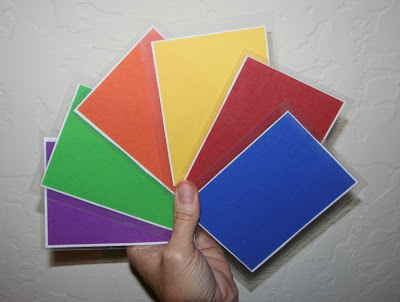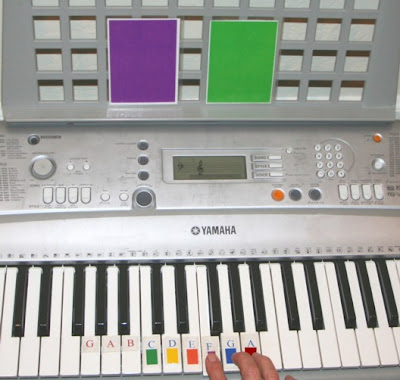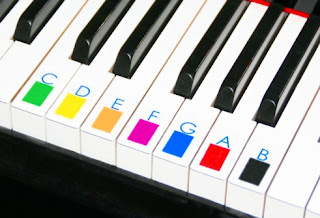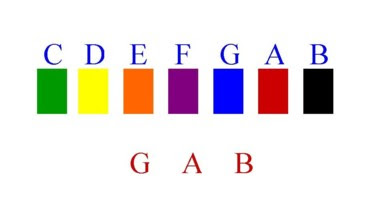Here's one more song to play on the keyboard using a color coded card.
Monday, January 25, 2010
Friday, January 22, 2010
Playing Twinkle Twinkle Little Star on the Keyboard
Once your child has the color recognition exercise mastered from the last entry, you can present them with a full song. Depending on their attention span and interest level, determine how much of the song to present at one time. I believe music activities should be fun for children, so I recommend that you cease presentation of an activity if a child loses interest or seems uncomfortable or indifferent. Go back to color recognition or take a break from the activity. You can always present it again at a later time to see if the response is positive.
Here is the keyboard color card for Twinkle, Twinkle Little Star:
.jpg)
For more Piano by Color songs, check out the Piano by Color Download on the Activity Download page above.
Here is the keyboard color card for Twinkle, Twinkle Little Star:
.jpg)
For more Piano by Color songs, check out the Piano by Color Download on the Activity Download page above.
Thursday, January 21, 2010
Practicing Color Recognition on the Keyboard
Once you have adhered the colors to the keys on your keyboard, create 3 X 5 inch cards that coordinate with the keyboard colors. I printed mine on regular paper, cut them out in 3 X 5 inch rectangles and laminated each card so it would last longer.
Depending on the attention span and interest level of your child, choose 1-5 cards and arrange them on the music stand of your keyboard. Point to the first color and ask the child to play the corresponding color on the keyboard.
Once mastered, change the order and number of colors until the child is proficient at matching the colors. If they are able, begin to have them point to the colored card on the music stand with the left hand and play the color on the keyboard with the right. In preparation of playing full songs on the keyboard, encourage the child to use open fingers and lay them on the keyboard (shown above)instead of curling the other fingers under the hand.
Tuesday, January 19, 2010
More Abilities than Disabilities
You may have seen this clip before, but if not, it is worth a few minutes of your time. This is a very inspirational story about a young man born with many disabilities who prefers to be defined by his "abilities" and the wonderful parents behind him. More proof of the ability of music to make a difference in a childs life...
Monday, January 18, 2010
Keyboard games that everyone can play
The keyboard can be used to work on many skills and objectives, and many children are very motivated to play it. Unfortunately many parents feel uncomfortable trying to teach any skills on the keyboard because they never learned to play themselves. The next few posts will be dedicated to keyboard activities to try with your children- even if you're not a musician!
I would recommend locating a keyboard that has at least 61 keys. The keyboard I have used and like the most in my practice is the Yamaha YPT-300AD Full-Size 61-Key Touch-Sensitive Keyboard. Unfortunately, I think it's been discontinued and I can't find it anywhere. Yamaha has another model that looks pretty close, the Yamaha YPT-320 61 Key Personal Keyboard with AC Adapter, Deluxe Keyboard Stand and Professional Headphones . I found it sold in a bundle with a keyboard stand and AC adapter through Amazon. There are also several other Yamaha keyboards available that would should work very well. I would caution against the lighted keyboards as I think they can be overstimulating for some children.
. I found it sold in a bundle with a keyboard stand and AC adapter through Amazon. There are also several other Yamaha keyboards available that would should work very well. I would caution against the lighted keyboards as I think they can be overstimulating for some children.
Here is a color chart that I use for the keyboard. The green "C" should be placed on the C in the middle of the keyboard - middle C. The re B, A, and G should go below the Green Tabbed Middle C.
You can make a chart like this on your computer or with colored paper and tape it to your keyboard. Warning - tape, if left on the keys too long can give your keys a tacky feel. For songs to play with your colors, check out Piano by Color on the Activity Download tab above.
Saturday, January 16, 2010
Autoharp Activities
Autoharp Activities. Place the autoharp on the floor between you, on your lap for more control, or on their lap if they can tolerate the vibration from the autoharp as it is played.
1. To practice counting, ask your child to count the strings on the autoharp as you pluck each string with a pick. Assist by counting with them.
2. Alphabet recognition: ask your child to press the “A”. If they get it right, use your pick to strum while they hold down the “A” key. Repeat with another key.
3. Alphabet recognition and motor coordination: Ask your child to press the “A” key with the pointer finger on one hand and strum the strings with a pick using the other hand. Repeat with another key.
4. Letter recognition: Show the child a card with a letter printed on it. Proceed with #2 and #3.
5. Play a simple song such as “Old MacDonald”. Have your child sing along or assist with the strumming.
C F C C G C
Old MacDonald had a farm., Ee-i-ee-i-oo.
C F C C G C
On that farm he had a cow, Ee-i-ee-i-oo
C C
With a moo moo here and a moo moo there.
C C C C
Here a moo, there a moo, everywhere a moo moo.
C F C C G C
Old MacDonald had a farm, Ee-i-ee-i-oo.
1. To practice counting, ask your child to count the strings on the autoharp as you pluck each string with a pick. Assist by counting with them.
2. Alphabet recognition: ask your child to press the “A”. If they get it right, use your pick to strum while they hold down the “A” key. Repeat with another key.
3. Alphabet recognition and motor coordination: Ask your child to press the “A” key with the pointer finger on one hand and strum the strings with a pick using the other hand. Repeat with another key.
4. Letter recognition: Show the child a card with a letter printed on it. Proceed with #2 and #3.
5. Play a simple song such as “Old MacDonald”. Have your child sing along or assist with the strumming.
C F C C G C
Old MacDonald had a farm., Ee-i-ee-i-oo.
C F C C G C
On that farm he had a cow, Ee-i-ee-i-oo
C C
With a moo moo here and a moo moo there.
C C C C
Here a moo, there a moo, everywhere a moo moo.
C F C C G C
Old MacDonald had a farm, Ee-i-ee-i-oo.
Thursday, January 14, 2010
Instrument of the week - autoharp!
I love using the autoharp during my sessions. This instrument can provide a terrific auditory and tactile experience. I like to lay it on the ground between me and the child I'm working with. I can then press the chords and assist the child in strumming as we sing. This instrument can also be placed on the childs lap, placed on the therapists lap or held against the therapists chest and strummed - wonderful for when you need to be mobile. his would be an excellent instrument to use at home due to the ease of playing and strong auditory and tactile stimulation. I found a wonderful clip on You Tube of a Music Therapist demonstrating the use of the autoharp and different picks and methods. Click on the following link to watch it. http://www.youtube.com/watch?v=QjXDF0j0mjQ
Wednesday, January 13, 2010
Music Lessons for Children with Special Needs
"Should my child take private instrument lessons?"
1. Is your child the one that is interested in taking the lessons? Ask yourself if your child has the desire to learn an instrument, or if YOU want them to learn to play an instrument.
2. Are you willing to support your child in planning a time to practice and helping them with their practice time?
3. Do the requirements of instrument lessons match the capabilities of your child? (attention span, cognitive capabilities, physical capabilities, etc.)
If you answered yes to the above questions, you may want to interview potential teachers. Be sure to let them know of your childs special needs and determine if they are equiped to deal with them. Ask if you could have a lesson or two to determine if the teacher/student relationship works. Personally, I feel that music lessons should be fun and provide children with a means of self expression and potentially increase self esteem. If the teacher applies too much pressure or is not supportive with the rate of progression, it may be a detrimental experience for your child.
Music Therapists are well equipped to provide music lessons for all children, including those with special needs. To find a Music Therapist in your area, contact your regional association of Music Therapy of The American Music Therapy Association. Their website is: http://www.musictherapy.org/
Tuesday, January 12, 2010
Apple, apple, a, a, a
I first heard this song many years ago when my children were small, but was blown away when I found out that the CD - "Sounds Like Fun" by Discovery Toys has been around for 20 years! This is a catchy little song that makes it very fun for children to practice the phonetic sounds of the alphabet. In case you are not familiar with the song, I recently found it on You Tube. Here is a link: http://www.youtube.com/watch?v=DK9VPtz3EHQ The CD is still available from Discovery Toys.
I created my own picture cards to use during my sessions so that I can vary the speed I sing the song depending on each client. I have also seen these put in a booklet form. Here is a snapshot of one of my cards - these would be easy to put together using clip art from your computer!

Subscribe to:
Posts (Atom)

.jpg)
.jpg)
.jpg)
.jpg)
.jpg)
.jpg)
.jpg)